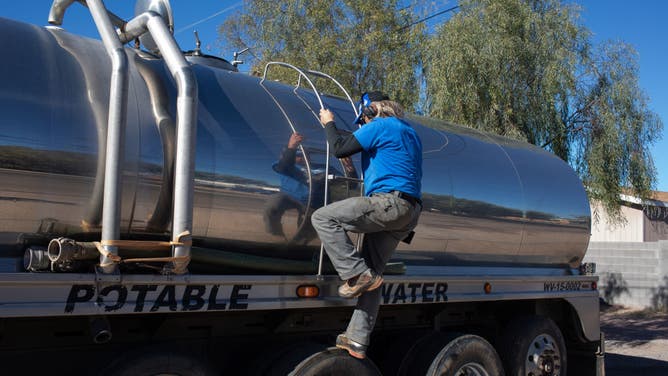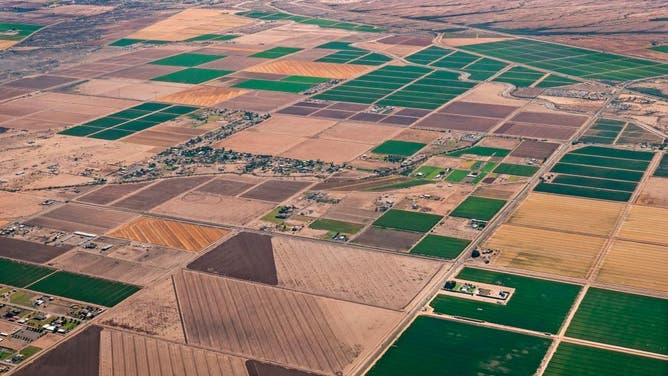'An exceptional case': Arizona suburb water supply cut off offers cautionary tale during continued drought
The town of Scottsdale says Rio Verde Foothills residents were warned for "many years" of impending water-supply cut-off. Water policy experts say the community is unique because it did not have a 100-year water supply plan required for all new developments by the Arizona Department of Water Resources.
Scottsdale, AZ cuts off water supply to nearby community in midst of a drought
Sarah Porter, Arizona State University Kyl Center for Water Policy Director, discusses why a Arizona neighborhood was cut off from their water supply and why this is an isolated incident.
SCOTTSDALE, Ariz. – For years, residents of Arizona's Rio Verde Foothills suburb bought their water from the city of Scottsdale, which was brought in by truck. On Jan. 1, the trucks stopped coming, and residents were forced to face the reality Scottsdale city officials warned was coming due to the ongoing 20-year drought.
About 1,000 residents in unincorporated Maricopa County say they have about five days of water supply left. Residents have been skipping showers, avoiding dishwasher use and trying to collect rainwater.
In response to the attention the water cut-off has been getting, Scottsdale officials clarified that Rio Verde Foothills had been warned for "many years" that the city was not responsible for the community’s water supply. A December notice of the impending cut-off cited notices dating back to 2015.
HOW TO WATCH FOX WEATHER ON TV
Rio Verde Foothills is part of unincorporated Maricopa County and not governed by Scottsdale; therefore responsible for its own 100-year water supply plan that needs to be certified by the Arizona Department of Water Resources.
Sarah Porter, director of the Kyle Center for Water Policy at Arizona State University, told FOX Weather the situation in Rio Verde is unique.

Stephen Coniaris talks with reporters after eating lunch at home in Rio Verde Foothills, Arizona, U.S. on January 9, 2023. Coniaris and his wife Donna have been eating off of paper plates and cooking in less water-consuming ways to limit the amount of hauled water they use.
There are a handful of other communities in Arizona, like Rio Verde, that pay outside cities for their water supply, but Rio Verde is "an exceptional case," according to Porter.
As a desert state, Arizona has one of the most rigorous water requirements in the country for new housing developments. Any new development of six or more homes must prove its water supply for 100 years.
Arizona suburb cut off from water supply by city of Scottsdale
Rio Verde Foothills resident Cody Reim joins FOX Weather to discuss how his community is coping with the loss of water access.
Porter said Rio Verde skirted this requirement because the landowners split their properties lot by lot and were not built under a master plan.
"Thinking about making sure of a long-term water supply never occurred. People bought their homes knowing that they were relying on water being hauled in from a truck," Porter said. "That's a fairly unusual situation in Arizona, especially in places near a city."
Should other neighborhoods worry about water supply?

John Hornewer climbs down the ladder of his tanker as he fills it up to haul water from Apache Junction to Rio Verde Foothills, Arizona, U.S. on January 7, 2023.
(Getty Images)
Arizona gets about 36% of its water supply from the Colorado River. For the past 20 years, water levels in Lake Mead, a large Colorado River reservoir, have been dropping amid drought conditions.
The Scottsdale-Rio Verde water cut-off on Jan. 1 was part of the Colorado River Tier 2 mandatory water cuts, which sliced Arizona's supply from the Colorado River by 21%.
At the beginning of the year, Arizona Gov. Katie Hobbs unsealed an Arizona Department of Water Resources report showing some developments in the Phoenix area fell 15% short of the 100-year water supply requirement.
NASA IMAGERY SHOWS LAKE MEAD WATER LEVELS LOWEST IN MORE THAN 80 YEARS
Some cities have the water infrastructure to support growth. However, others don’t.
"Each city takes care of its own water portfolio. And some cities like Phoenix have robust portfolios that can support a lot of growth," Porter said. "There are some cities, especially in the far-flung areas, where they weren't around when water was being allocated, that are more challenged."
The unsealed water report highlighted one area in particular, a suburb called Buckeye in the far west valley of the Phoenix area. According to the city's website, Buckeye is "one of the fastest-growing cities in the country."
Porter said as the population grows, water planning is a must.
"If they want to continue to develop new housing subdivisions in order to meet that 100-year water supply requirement, they're going to have to go find new water supplies," Porter said. "There is a range of options for those supplies."
Arizona's agriculture industry hardest hit by water cuts

File photo: Aerial view of farmlands in Pinal County, Arizona. Aerial support by LightHawk. (Photo by: Wild Horizon/Universal Images Group via Getty Images)
(Getty Images)
Arizona Department of Water Resources (DWR) Director Tom Buschatzke told FOX Weather 2023 marks the state's second year of Colorado River water cuts.
Arizona’s agriculture industry will see the most significant impact from the Colorado River supply reduction. Farmers were also hardest hit in 2022 during the first year of cuts.
Irrigated agriculture is the largest user of water in the state, consuming about 74% of the available water supply, according to the DWR.
"Some of our farmers have already lost their water supplies in the central part of Arizona. We’re going to see tribes and cities lose their water supply as well, or at least some of them," Buschatzke said.
However, for the most part, residents won’t have to restrict water use inside their homes.

